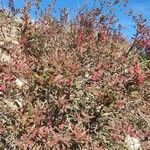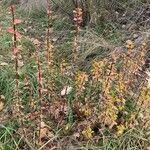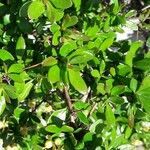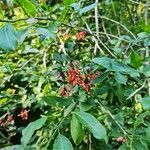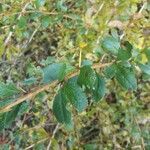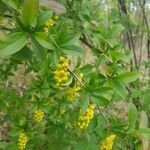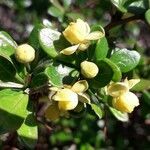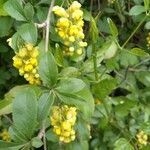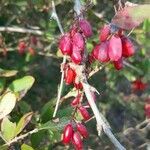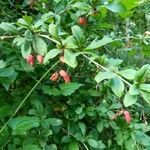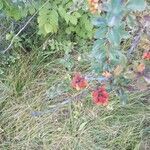Glabrous, deciduous shrub to c. 2 m high. Shoots angled. Spines generally 3-partite, < 1.5 cm long on adult shoots. Petiole to 1 cm long; lamina 2-8 × 1-2.5 cm (often some very small lvs on flowering spurs), elliptic to obovate, membranous, dull green above, usually serrulate, sometimes entire; base attenuate; apex obtuse. Fls in racemes to c. 6 cm long at anthesis. Bracts 1-2 mm long, ovate or lanceolate-ovate. Pedicels 5-10 mm long. Perianth segments medium yellow, those of outermost whorl smaller, ovate; innermost sepals c. 5 mm long, obovate; petals c. 5 mm long, obovate,± rounded at apex. Nectaries c. 1 mm long, prominent, orange. Stamens 2-3 mm long. Ovules 2. Stigma sessile. Berry 9-11 mm long, oblong, scarlet or crimson-scarlet, shining.
Deciduous shrub to 3 m high; stems glabrous, dimorphic with elongate primary and short axillary shoots. Leaves on main stems reduced to terete, usually 3-fid spines (deeply divided into 3, sometimes simple) 10–25 mm long. Secondary leaves occur on short shoots; lamina obovate to elliptic, mostly 2–6 cm long and 8–25 mm wide (sometimes larger), thin, base short-to long-attenuate, margin finely serrate (± regularly toothed with numerous bristly to spiny teeth), apex obtuse to rounded; petiole to 8 mm long. Racemes terminating lateral shoots, many-flowered, 2–7 cm long, pendent in fruit; pedicels c. 10 mm long. Flowers c. 5 mm diam., perianth yellow. Berry obloid to ovoid, 9–12 mm long, ripening bright red, retaining ± sessile stigma; seeds 1–3.
A shrub. It loses its leaves during winter. It grows about 2.5-3.5 m tall. It has several stems. It has spines. The spines are grouped in threes. The leaves and flowers grow on short side shoots in the axils of the spines. The leaves are dark green above and pale green underneath. They are alternate and 2.5-5 cm long. The flowers are yellow and occur in hanging clusters. They are 6 mm across. The fruit are red berries. They are 1.25 cm long. They contain 2-3 small seeds. They are edible.
Freely branched, to 3 m, the twigs gray or yellowish-gray; lvs obovate or obovate-oblong, 2–5 cm, finely spinulose-denticulate, the veinlets prominently reticulate beneath; racemes 3–6 cm, with 10–20 fls on pedicles 5–10 mm; pet entire; fr 1 cm, tart; 2n=28. Native of Europe, formerly much planted and escaped, now largely purposefully exterminated as the alternate host of the common “stem” rust of wheat. May, June.
